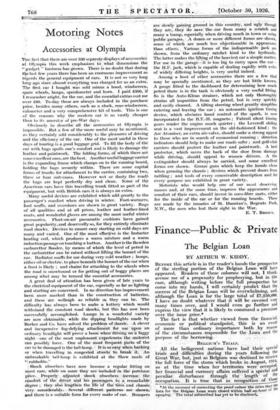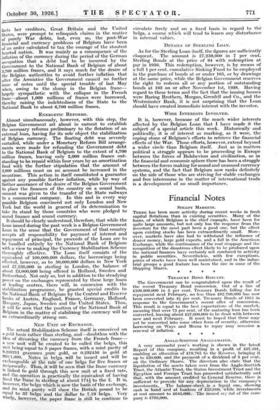Finance—Public & Private
The Belgian Loan
BY ARTHUR W. KIDDY.
BEFORE this article is in the reader's hands the prospectus of the sterling portion of the Belgian Loan will have appeared. Readers of these columns will not, I thinly accuse me of a propensity for prophesying, but in thi case, although writing before the ftill prospectus has come into my hands, I will certainly predict that the success of the Belgian Loan will be overwhelming, and although the Loan is for the 'large total of £7,250,000, I have no doubt whatever that it will be covered very many -times over, and I would' even go further and express the view that it is likely to command a premium over the issue price.* The fact is that whether viewed from the financial; economic or political standpoint, this is an event of more than ordinary importance both , by reason Of the circumstances responsible for the Loan and the purpose of the borrowing.
BELGIUM'S TRIALS.
All the belligerent nations have had their special `trials and difficulties during the years following the Great Wir, but, just as Belgium was destined to receive the full force of the storm which broke in .August, 1914, so at the time when her territories were occupied; her financial and currency affairs suffered a special mid peculiar disturbance through the length - of the Occupation. It is true that in recognition of thosc
*At the moment of correcting the proof comes the news that the lists for the -Belgian Loan were closed within half-an-hour of the opening. The total subscribed has yet to be disclosed.
facts her creditors, Great Britain and the United States, were prompt to relinquish claims in the matter of purely War _debts, but, even so, the post-War financial - and - currency problems of Belgium have- been of an order calculated to tax the courage of the stoutest hearted nation. It was mainly as a consequence of the inflation of the currency during the period of the Geiman occupation that a debt had to be incurred by the Government to the National Bank of Belgium of about 5,700 million francs, and it says much for the desire of the Belgian authorities to avoid further inflation that after the Armistice the Government caused- no further issue of notes until the special trouble of last May when, owing to the. slump in the Belgian franc— largely sympathetic with the collapse in the French franc—about 1,000 millions of francs were borrowed, thereby raising the indebtedness of the State to the National Bank to about 6,700 million francs.
ENERGETIC REFORMS.
Almost simultaneously, however, with this step, the Belgian Government set about in earnest to establish the necessary reforms preliminary to the flotation of an external loan, having for its sole object the stabilization of Belgian currency. The floating debt was severely curtailed, while under a Monetary Reform Bill arrange- ments were made for refunding the Government debt to the National Bank of Belgium to the extent of 4,700 million francs, leaving only 2,000 million francs out- standing to be repaid within four years by an amortization fund with the further stipulation that - the amount of 2,000 millions must on no account be increased in the meantime. This action in itself constituted a guarantee against any possible further inflation, while by way of further assurance of the desire of the Belgian Government to place the finances of the country on a sound basis, consent was given to the transfer of the State railways to a commercial company. In this and in every way possible Belgium convinced not only London and New York but the world in general of its determination to take its stand by those countries who were pledged to sound finance and sound currency. It should be clearly understood, therefore, that while the Loan issued during the past week is a Belgian Government Loan in the sense that the Government of that country accepts all responsibility for payment of interest and repayment of principal, the proceeds of the Loan are to be handled entirely by the National Bank of Belgium with a view to making the Currency Stabilization Sdheme thoroughly effective. The Loan itself consists of the equivalent of 100,000,000 dollars, the borrowings being effected, however, as to 50,000,000 dollars in New York and £7,250,000 in sterling in London, the balance of about £3,000,000 being offered in Holland, Sweden and Switzerland. Not only so, but in addition to the steadying power on the exchanges represented by these large loans at leading centres, there will, in connexion with the stabilization programme, be granted special credits to the National Bank of Belgium by the Central and Reserve banks of Austria, England, France, Germany, Holland, Hungary, Japan, Sweden and the United States. Thus, it will be seen that the position of the National Bank of Belgium in the matter of stabilizing the currency will be an extraordinarily strong one.
NF.w UNrr OF EXCHANGE.
The actual Stabilization Scheme itself is conceived on a gold basis rather than sterling, and—doubtless with the idea of diVorcing the currency from the French franc- a new unit will be created to be called the belga, this unit being equal to 5- paper francs, with a mint parity of 0.209211 grammes pure gold, or 0.232456 in gold at 900/1,000. Notes in belga will be issued and will be exchangeable at the rate of one belga fOr five francs or reciprocally. Thus, it will be seen that the franc currency is linked to gold through this new unit at a fixed rate, and the operation is practically the equivalent of having fixed the franc in sterling at about 174i to the £. It is, however, the belga which is now the basis of the exchange, and its mint parity will show the British pound to be equal to 35 belga and the dollar to 7.19 belga. Very wry, however, the paper franc is still to continue to circulate freely and on a fixed basis in regard to the belga, a course which will tend to lessen any disturbance in internal value's.
DETAILS OF STERLING LOAN.
As for the Sterling Loan itself, the .figures are sufficiently eloquent- .The amount is 17,250,000 in 7 per cent. Sterling Bonds at the price of 94 with redemption at par in 1956. This redemption, however, is by means of a full 1 per cent. cumulative Sinking Fund to be employed in the purchase of bonds at or under 105, or by drawings at the same price, while the Belgian Government reserves the right to redeem all or any portion of outstanding bonds at 105 on or after November 1st, 1938. Having regard to these terms and the fact that the issuing houses were Baring Brothers, Morgan, Grenfell and Co., and the Westminster Bank, it is not surprising that the Loan should have created immediate interest with the investor.
WIDE INTERESTS INVOLVED.
It is, however, because of the much wider interests affected by the Belgian Loan that I have made it the subject of a special article this week. Historically and politically, it is of interest as marking, as it were, the coping stone of Belgium's efforts to retrieve the financial effects of the War. Those efforts, however, extend beyond a wider circle than Belgium itself. Just as in matters political a struggle appears to be proceeding in Europe between the forces of Bolshevism and civilization, so in the financial and economic sphere there has been a struggle between the forces making for sound and unsound currency systems, and the fact that Belgium now ranks definitely on the side of those who are striving for stable exchanges and free intercourse in the matter of international trade is a development of no small importance.



























































 Previous page
Previous page